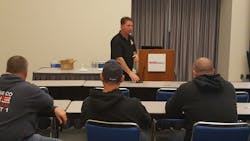SAN DIEGO – Jesse Quinalty, a captain with the Upland, CA, Fire Department and co-founder of Red Helmet Training, doesn’t like the current acronyms the fire service has for tactical firefighting, so he made some of his own.
SLAB SAVERS sounds like a derogatory term that some might use to describe firefighter incompetence, but not for Quinalty. At the Firehouse World conference, he described what the two acronyms mean and they are not at all detracting to the fire service.
“For me as a captain, RECEOVS, wasn’t working, and SLICER doesn’t work either as it is not command based,” he said.
As a refresher, RECEOVS means Rescue, Exposures, Confinement, Extinguish, Overhaul, Ventilation, Salvage. And SLICER means Size-up, Locate, Identify, Cool, Extinguish, Rescue.
To that alphabet soup, added the following from Quinalty.
SLAB means, Safety profile, Life profile, Air track and Building. SAVER means Search and rescue, Attack, Ventilation, Extension and exposure, Rapid intervention crew and salvage.
“I am building a foundation in strategy and tactics,” Quinalty said, adding that he believes the other more well-known acronyms have the potential to put firefighters in offensive positions on defensive fires.
As an initial incident commander in his role a captain, Quinalty said he’s learned that it’s not a good idea to assign an engine company both fire attack and primary search.
“One of those tasks are not going to happen,” he said. “The only time searching is going to happen is if they trip over someone.” That is one of the reasons why he said he needed new acronyms.
Quinalty said his acronyms can accommodate other tactics like rules of engagement, survivability profile and transitional fire attacks.
“We fight fires, there are going to be risks involved,” he said. “But, there are buildings we shouldn’t be in. There are roofs we shouldn’t be on.” He said it’s very difficult to justify aggressive interior attacks when there are no occupants or property to save.
Quinalty said all fire departments should have the risk assessment written into their standard operating procedures (SOPs); risk a lot to save a lot; risk a little to save a little; risk nothing to save nothing.
He’s not a big fan of the phrase “calculated risk.” As commanders do the risk assessment, two minutes can completely change a fire scene with modern fire behaviors. He said commanders have to look at a much bigger picture and realize that if a commander is responsible for a firefighter's injury or death, that commander is liable.
Quinalty said as a company officer or a chief officer, your role and thinking are going to change.
“My outlook has changed,” he said. To illustrate it, he showed a video of a well-involved structure fire with smoke issuing out of just about everywhere it could. The video, which he said was about 15 years old, was part of his curriculum to show what an aggressive truck company could do to improve conditions with vertical venting.
“I used to show this to illustrate what a bad-ass truck company could do,” Quinalty said. “Now, I show it to tell you what you shouldn’t do.” He said there was no reason for firefighters to risk their lives venting a roof on what appeared to be an abandoned home that was already significantly compromised by fire. He also said there’s a big difference between vacant and abandoned. Vacant just means no one is home at the time of the fire and abandoned means they’ve been gone a long time and are probably not coming back.
Quinalty said commanders have 30 seconds to make a decision to do an offensive interior attack or go defensive and there’s a trigger point when the decision is made.
“When you are ripping off boards [on an abandoned house] to go inside, that doesn’t make sense,” he said.
Quinalty said his perspective on firefighting changed about 11 years ago when he found himself and his crew trapped in a garage during a wildland fire. That prompted him to take risk assessment very seriously and follow the rules of engagement. Since then, he started the training company and became involved in the Everyone Goes Home initiative with the National Fallen Firefighters’ Foundation (NFFF).
“Now my goals are to stay safe and survive,” he said.
Quinalty also spoke about the difference between known and unknown rescues. He said if a bystander reports someone may be inside, that’s an unknown rescue. A known rescue is someone reporting a victim is definitely inside and reports an exact whereabouts the individual is located.
“Does that make a difference in your decision?” he asked “It should.”
Quinalty said there are no right or wrong answers to many of questions he was presented, which is why he believes his acronyms work as they allow the incident commander to make decisions based on communications, size-up and conditions.
He also said transitional firefighting, where water is applied from the outside, works and keeps firefighters out of harm's way or taking unnecessary risks.
“You can put out a lot of fire from the outside,” he said. “…Putting the fire out saves victims.”
He said victims will not survive long in today’s fires with the fuels and construction types.
“We’re not dragging them out and saving them much anymore,” he said.
Quinalty said fire departments should be careful teaching new recruits by filling up rooms with simulated smoke and letting them crawl through it.
“In today’s environment, that’s not OK,” he said. “They really shouldn’t be crawling through that smoke. We are teaching them stuff they shouldn’t do.”
Knowing the community and identifying hazards is always a good practice, Quinalty said. And fire commanders should always profile the structure and assess conditions before making an attack. He used a red light, yellow light, green light analogy to help commanders make that attack decision.
“And remember, the best way to save people is to put the fire out, “he said.






